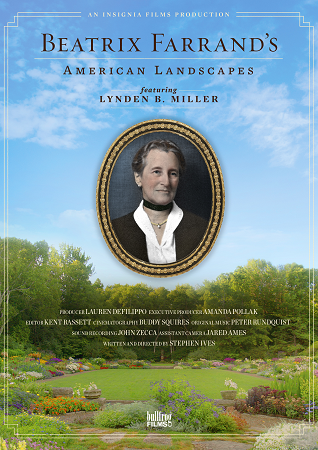
Beatrix Farrand's American Landscapes 2020
Distributed by Bullfrog Films, PO Box 149, Oley, PA 19547; 800-543-FROG (3764)
Produced by Lauren DeFilippo, Karen Smythe, and Anne Cleves Symmes
Directed by Stephen Ives
Streaming, 62 mins
General Adult
Biography; Gardening; Landscape Design
Date Entered: 09/25/2020
Reviewed by James E. Sobczak, STEM Librarian, University of MiamiBeatrix Farrand’s American Landscapes is a biographical documentary that constructs, in rich detail, the personal history and professional work of landscape architect Beatrix Farrand.
As one of the first female practitioners of the then-emerging field of landscape architecture, this film creates a vivid portrait of a pioneering woman driven by her conviction to bring beauty and functionality to the design of both private and public gardens. Besides breaking new ground as a practicing female landscape architect, Farrand’s horticultural expertise also led to garden design choices that were far ahead of her time, including advocacy for using native plants and the promotion of gardens as communal spaces for public health and education.
While not a comprehensive overview of her entire body of work, this film does visit some of her most well-known projects including portions of the Princeton University campus; Bellefield Garden in Hyde Park, NY; New York Botanical Garden’s Rockefeller Rose Garden; Dumbarton Oaks in Washington, DC; the carriage roads in Acadia National Park; The Eyrie in Seal Harbor, ME; and the Garland Farm terrace garden near Bar Harbor, ME. For a roughly 60-minute film, this curated list of projects allows for a very enjoyable cinematic pace - not lingering too long or departing too quickly from any one particular site. Each garden or park is given an amount of screen time and investigative consideration relative to the project’s importance in the overall career trajectory of Farrand.
Guiding the audience on this journey is Lynden B. Miller, a noted garden designer and public space advocate in her own right. As she meanders through several of the extant works of Beatrix Farrand, she interweaves her commentary on their design elements with in-person interviews with several landscape historians, authors, garden directors, as well as the general public. Her narrations and interviews are further augmented with archival photographs, drawings, and film clips. These visuals not only help to tell the story of how Farrand’s designs materialized, but they also provide rich historical context for her life and work.
Due to Miller’s obvious admiration and reverence for Farrand, the film’s periodic segues into Miller’s own personal works and commissions are forgivable tangents away from the main biographical narrative of Farrand’s story. If nothing else, Miller’s personal interjections help show the unbroken influence and evolution of landscape gardening from past to present through the lens of two women who have mastered and championed their craft.
This film, with its compelling biographical subject and wonderful storytelling, would be of interest to anyone attracted to the history of garden design, horticulture, or landscape architecture in the United States during the first half of the 20th century. Beatrix Farrand’s American Landscapes is a highly recommended addition to any public or academic library collection.